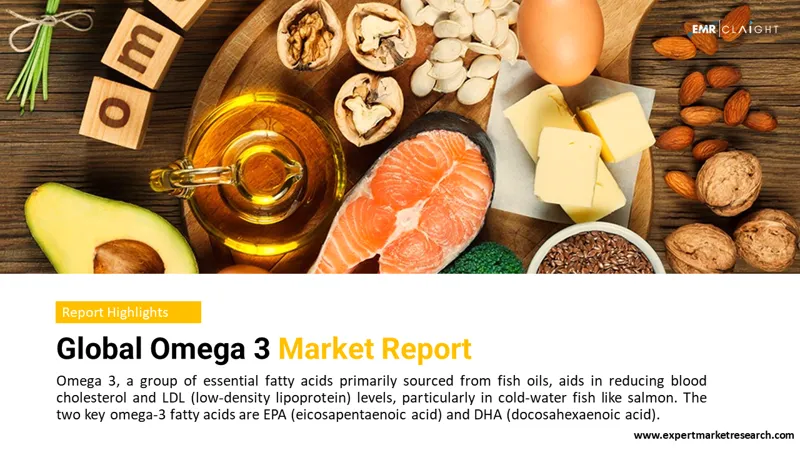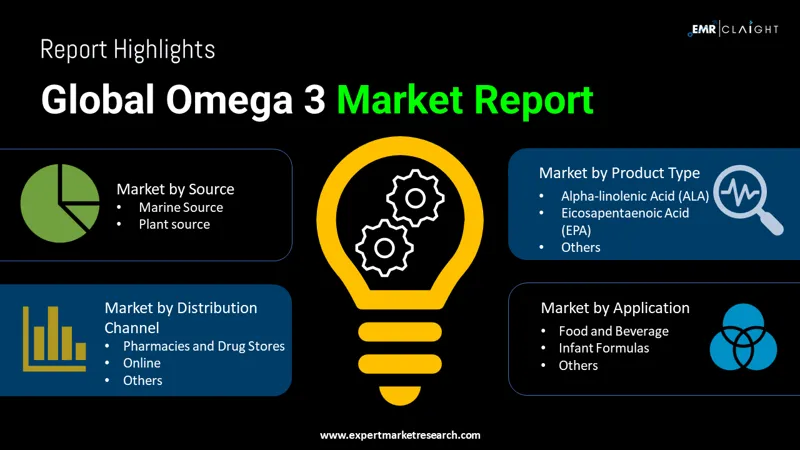
Consumer Insights
Uncover trends and behaviors shaping consumer choices today
Procurement Insights
Optimize your sourcing strategy with key market data
Industry Stats
Stay ahead with the latest trends and market analysis.
The global omega 3 market reached a value of about USD 3.82 Billion in 2025. The market is further expected to grow at a CAGR of 8.00% in the forecast period of 2026-2035 reaching a value of USD 8.25 Billion by 2035.
Base Year
Historical Period
Forecast Period
Compound Annual Growth Rate
8%
Value in USD Billion
2026-2035
*this image is indicative*
Based on source, the fish oil segment under the marine sector accounts for a significant share in the omega 3 industry. The high content of EPA (eicosapentaenoic acid) and DHA (docosahexaenoic acid) present in fish oil are responsible for driving the market growth. The species like anchovies and sardines are rich in omega-3 fatty acids and other species like tuna and salmon are also a popular choice among manufacturers. In addition, the increase in demand for medication with fish oil, increasing prevalence of chronic diseases, and the health benefits it offers are also contributing to the market growth.

Read more about this report - REQUEST FREE SAMPLE COPY IN PDF
Region-wise, the Asia Pacific is expected to witness a robust growth over the forecast period owing to the high demand for fortified food in the region. Furthermore, countries like China, India, and South Korea are expected to significantly contribute to the industry growth due to the growing food supplement market in the regions.

Read more about this report - REQUEST FREE SAMPLE COPY IN PDF
Omega 3 is a class of essential fatty acids found in fish oils. It helps to lower blood cholesterol and LDL (low-density lipoprotein) levels, especially those of salmon and other cold-water fish. (The "bad" cholesterol is LDL cholesterol.) The two principal omega-3 fatty acids are EPA (eicosapentaenoic acid) and DHA (docosahexaenoic acid).
By source, the market is divided into:
Based on product type, the market is categorised into:
By distribution channel, the market is segmented into:
On the basis of application, the market is categorised into:
On the basis of region, the market is categorised into:
With the growth in people being forced to choose a sedentary lifestyle because of work, more and more people are getting affected by chronic as well as lifestyle disorders. The rise in the prevalence of diseases such as heart and joint inflammation, combined with the increase in population globally, is likely to increase the demand for medication and food products containing omega 3 fatty acids. This will lead to the growth of the market. Further, the increase in demand for DHA and EPA in diet has impacted the industry in a positive way. Even though there are many benefits related to fish oil, the cost of the supplement is quite high and unstable because of the high price of fishes used as an ingredient. Thus, this may hinder the growth of the omega 3 industry.
Over the forecast period, growth of the food supplement industry and the rising awareness about the benefits of fish oil are expected to favour the industry growth. The worldwide increase in the number of people affected by cardiovascular diseases is expected to aid the industry growth in the coming years.
The report gives a detailed analysis of the following key players in the global omega 3 market, covering their competitive landscape, capacity, and latest developments like mergers, acquisitions, and investments, expansions of capacity, and plant turnarounds:
The comprehensive EMR report provides an in-depth assessment of the market based on the Porter's five forces model along with giving a SWOT analysis.




*While we strive to always give you current and accurate information, the numbers depicted on the website are indicative and may differ from the actual numbers in the main report. At Expert Market Research, we aim to bring you the latest insights and trends in the market. Using our analyses and forecasts, stakeholders can understand the market dynamics, navigate challenges, and capitalize on opportunities to make data-driven strategic decisions.*
Get in touch with us for a customized solution tailored to your unique requirements and save upto 35%!
The omega 3 market attained a value of nearly USD 3.82 Billion in 2025.
The market is projected to grow at a CAGR of 8.00% between 2026 and 2035.
The rising population levels, the surging global population, and the increasing prevalence of chronic diseases are the major market drivers.
The key trends guiding the market include the rising demand for fortified food, the growing awareness regarding the benefits of fish oil, the surging prevalence of lifestyle-related diseases, and the increasing demand for food supplements.
The major regions in the market are North America, Latin America, the Middle East and Africa, Europe, and the Asia Pacific.
Docosahexaenoic Acid (DHA), alpha-linolenic acid (ALA) and eicosapentaenoic Acid (EPA), among others are the significant product types in the market.
The major sources of the product are marine source and plant source.
The major product types considered in the market report are docosahexaenoic acid (DHA), alpha-linolenic acid (ALA), and eicosapentaenoic acid (EPA), among others.
Hypermarkets and supermarkets, pharmacies, and drug stores and online, among others are the leading distribution channels of omega 3.
The various applications of omega 3 are dietary supplements, pharmaceuticals, animal feed and pet food, food and beverage, and infant formulas, among others.
The major players in the market are Cargill Incorporated, Reckitt Benckiser Group plc, Aker Biomarine Antarctic As, BASF SE, Omega Protein Corporation, Unilever Plc, and Koninklijke DSM N.V., among others.
Explore our key highlights of the report and gain a concise overview of key findings, trends, and actionable insights that will empower your strategic decisions.
| REPORT FEATURES | DETAILS |
| Base Year | 2025 |
| Historical Period | 2019-2025 |
| Forecast Period | 2026-2035 |
| Scope of the Report |
Historical and Forecast Trends, Industry Drivers and Constraints, Historical and Forecast Market Analysis by Segment:
|
| Breakup by Source |
|
| Breakup by Product Type |
|
| Breakup by Distribution Channel |
|
| Breakup by Application |
|
| Breakup by Region |
|
| Market Dynamics |
|
| Competitive Landscape |
|
| Companies Covered |
|
| Report Price and Purchase Option | Explore our purchase options that are best suited to your resources and industry needs. |
| Delivery Format | Delivered as an attached PDF and Excel through email, with an option of receiving an editable PPT, according to the purchase option. |
Datasheet
One User
USD 3,299
USD 2,969
tax inclusive*
Single User License
One User
USD 5,499
USD 4,949
tax inclusive*
Five User License
Five User
USD 6,999
USD 5,949
tax inclusive*
Corporate License
Unlimited Users
USD 8,199
USD 6,969
tax inclusive*
*Please note that the prices mentioned below are starting prices for each bundle type. Kindly contact our team for further details.*
Flash Bundle
Small Business Bundle
Growth Bundle
Enterprise Bundle
*Please note that the prices mentioned below are starting prices for each bundle type. Kindly contact our team for further details.*
Flash Bundle
Number of Reports: 3
20%
tax inclusive*
Small Business Bundle
Number of Reports: 5
25%
tax inclusive*
Growth Bundle
Number of Reports: 8
30%
tax inclusive*
Enterprise Bundle
Number of Reports: 10
35%
tax inclusive*
How To Order

Select License Type
Choose the right license for your needs and access rights.

Click on ‘Buy Now’
Add the report to your cart with one click and proceed to register.

Select Mode of Payment
Choose a payment option for a secure checkout. You will be redirected accordingly.
Gain insights to stay ahead and seize opportunities.

Get insights & trends for a competitive edge.

Track prices with detailed trend reports.

Analyse trade data for supply chain insights.

Leverage cost reports for smart savings

Enhance supply chain with partnerships.

Connect For More Information
Our expert team of analysts will offer full support and resolve any queries regarding the report, before and after the purchase.
Our expert team of analysts will offer full support and resolve any queries regarding the report, before and after the purchase.
We employ meticulous research methods, blending advanced analytics and expert insights to deliver accurate, actionable industry intelligence, staying ahead of competitors.
Our skilled analysts offer unparalleled competitive advantage with detailed insights on current and emerging markets, ensuring your strategic edge.
We offer an in-depth yet simplified presentation of industry insights and analysis to meet your specific requirements effectively.
Share